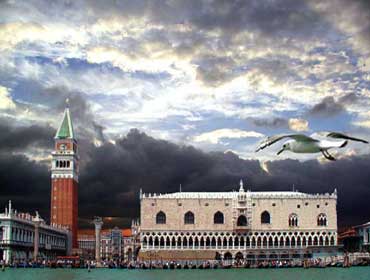
The current form of the square comes from successive expansions and changes that affected the area over the centuries. Originally the area was destined to garden and crossed the stream Batario, which links the existing canals and the mint stand. The Ducal Palace, equipped with a real castle towers and defenses, was surrounded by a canal and the area opposite the current square there was a dock for loading and unloading. With the arrival of the body 828 in Venice San Marco and the construction of the first Basilica of San Marco area began to take its importance as a monumental center of the city. In 976 the whole area was destroyed by fire, but already in 978 and a second church building have been rebuilt. The current basilica dates from the years 1050-1094, with the third foundation of the building. At that time the Brolo (the garden, garden trees) of the Nuns of San Zaccaria was opposite the Basilica of San Marco. In 1156 the Rio Batario was buried, as the basin was built and the Piazzetta. In 1172 the square was expanded to make room for new monumental buildings: the church of San Gimignano was placed on the edge of the new St. Mark's Square and were also placed two huge granite columns (from Constantinople) facing each pier, to represent ' access to the Mark. Column was placed above a symbol of the winged lion of St. Mark and the other was placed the statue of St. Theodore, Venice's first patron. He was born in this area so divided into two squares. In 1204 the conquest of Constantinople by the Fourth Crusade the Venetians gave the opportunity to decorate the Square and Basilica with marble and works of art. On this occasion he reached the Quadriga of San Marco, placed as decoration in the Basilica. Finally in 1264 the square was paved with bricks laid in a herringbone pattern. Between 1301 and 1442, after a series of modifications and work, the Ducal Palace lost its military aspect until it reached its current shape. Between 1495 and 1517 were instead made the Procuratie Old and the Clock Tower, while in the meantime proceeded to remove all the orchards and warehouses still in place. Sansovino was the great innovator of the square, which transformed it into a superb example of classic Roman, giving a new look at the cultural square, and adds between 1536 and 1540 the library and the loggia at the foot of the tower. Then between 1582 and 1640 created the new Procuratie. Andrea Tirali in 1723, he replaced the old flooring with the current trachyte Euganean Quarry Mount blackbird in Padua. Finally in 1807 the Napoleonic demolished the church of San Gimignano and built the 'Napoleonic Wing (also known as the Royal Palace or get-new), giving Mark the area final appearance today. The early morning hours of Monday, July 14, 1902 St. Mark's bell tower because of a previous leak, fell suddenly demolished the loggia and a corner of the library and threatening to bring even if the same basilica.
Nessun commento:
Posta un commento